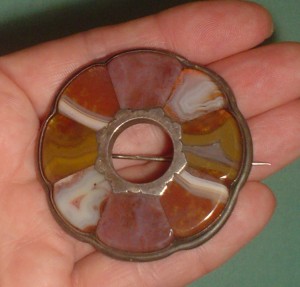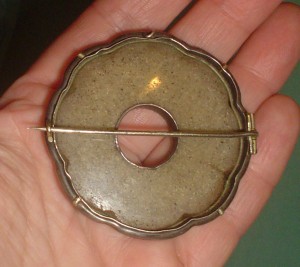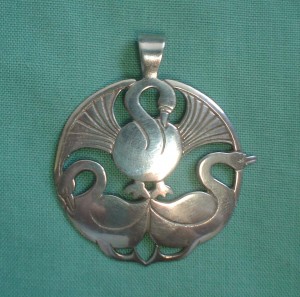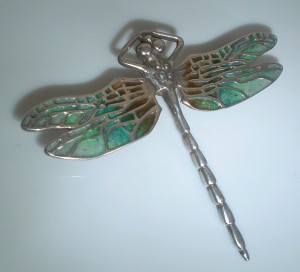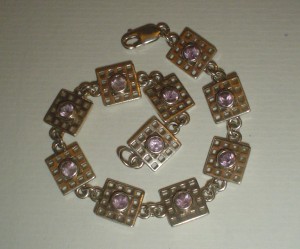If you said the words “Scottish jewellery” to a lot of people, it would conjure up an image of a kilt pin made from the foot of a dead grouse and perhaps embellished with a thistle motif – great for wearing on a kilt at some ceremonial occasion, but not the sort of thing most of us would consider as a suitable jewellery item in any other context. However, there is plenty of Scottish silver jewellery which is completely thistle-free apart from possibly the hallmarks, as I hope this article will demonstrate. A lot of Scottish silver jewellery is absolutely beautiful and in some cases has much in common with work by Scandinavian modernist designers. I will be concentrating mainly on jewellery made after about 1950, because it’s where my interests lie and there is quite a lot of material from the Fifties onwards.
Hallmarks on Scottish silver
Being part of the UK, Scotland uses British silver hallmarks which comprise
- a mark to denote the standard of silver, i.e. the fact that it’s 925 parts per 1,000 pure or “sterling”
- a town/assay office mark
- a date letter, and possibly
- a maker’s mark.
The two main assay offices for Scottish silver are Edinburgh, which is still going today, and Glasgow, which closed down in 1964. The town mark for Edinburgh is a castle with three turrets – nice and easy to identify – while the one for Glasgow is a rather blobby tree with what looks like a Christmas ornament dangling from it and a post stuck through the trunk. In fact, the ornament is meant to be a bell while the “post” is a fish!
The standard mark for Edinburgh silver pieces made between 1759 and 1975 is a thistle, while the one for Glasgow is a lion rampant. In case you were wondering, a lion rampant is one which is rearing up on its hind legs. Not to be confused with the lion passant – a lion on all fours – which is used as the standard mark for English silver. Just to muddy the waters a bit further, the thistle on Edinburgh silver was replaced with a lion rampant in 1975.
If you want to see how Scottish hallmarks have evolved through the ages, a good place to start is my page listing links for date letters on British and Scandinavian silver.
Scottish silver jewellery made with agates
Agates are a type of chalcedony formed when silica-bearing solutions penetrate into cooled volcanic lava. After millions of years, the resulting “nuggets” of agate finally get exposed on the surface of the ground and can be collected. In fact, during the 19th century agates could easily be found on Scottish beaches which is why jewellery made with agate stones was often known as “pebble jewellery”. Agates can still be found at various locations all over Scotland. They come in all sorts of colours and patterns; the colour is influenced by the type of impurity (for example carnelian agate, which has a reddish hue, contains traces of iron oxides). Victorian silver/agate jewellery is highly collectable and often commands a three-figure price.
The pictures below show a typical example of a Victorian silver agate brooch, viewed front and back.
Some places in Scotland where silver jewellery is made
Iona. Iona is a small island off the westernmost tip of Mull in the Inner Hebrides. If you see the stamp “CAI” on a piece of Scottish silver, it stands for Celtic Art Industries, which was founded in Glasgow in 1945 by Hamish Dawson-Bowman. Dawson-Bowman’s work was inspired by that of Alexander and Euphemia Ritchie, who had a shop on Iona. Makers who have worked for CAI include Iain McCormick, Malachy Gormley and John Hart (senior). CAI jewellery has a strong Celtic influence, with plenty of knotwork and scrolling.
South Uist. An island in the Outer Hebrides, and home to a silver jewellery making business called Hebridean Jewellery. Started in 1974 by John Hart senior’s son, who is also named John Hart.
The Orkney Islands. Situated off the north-east tip of Scotland, the Orkneys are home to Ola Gorie who started as a jewellery designer in the 1960s after she returned to the Orkneys on graduating from art college. Ola Gorie herself has retired but the company she founded lives on. Other Orkney designers/companies include Sheila Fleet and Ortak, which was founded by Malcolm Gray. Being closer to Scandinavia, there’s more of a Norse influence than with jewellery from the Hebrides.
Map of Scotland
Another Scottish silver jewellery designer you might not have heard of…
…is Norman Grant. Born in 1943, Norman Grant designed jewellery during the late Sixties and throughout the Seventies, mostly in enamel and silver. He used lots of plant and animal motifs in his jewellery, much of which is reminiscent of Art Nouveau pieces and is now very sought after.
Norman Grant dragonfly brooch
The influence of Charles Rennie Mackintosh
© Empress Felicity 2016
This article first appeared on HubPages.

